 |
Flying High With Electric Power!
The Ampeer ON-LINE!
Fly the Future - Fly Electric! |
Site Table of Contents
| President: | Vice-President: | Secretary/Treasurer: |
| Ken Myers | Richard Utkan | Rick Sawicki |
| 1911 Bradshaw Ct. | 240 Cabinet | 5089 Ledgewood Ct. W. |
| Commerce Twp., MI 48390 | Milford, MI 48381 | Commerce Twp., MI 48382 |
| (248) 669-8124 | (248) 685-1705 | 248.685.7056 |
 | ||
| Board of Directors: | Board of Directors: | Ampeer Editor |
| David Stacer | Jack Lemon | Ken Myers |
| 16575 Brookland Blvd. | 8908 Sandy Ridge Dr. | 1911 Bradshaw Ct. |
| Northville, MI 48167 | White Lake, MI 48386 | Walled Lake, MI 48390 |
| 248.924.2324 | 248.698.4683 | 248.669.8124 |
| Mailed Ampeer subscriptions are no longer available | ||
| The Next Meeting:
Date: March 11 Time: 7:30 p.m. Place: Ken Myers' house (see this issue for details) | ||
|
From: Ned Watts nedwatts@mac.com Rich sent a very nice "recovery" card to me and included a couple of good photographs. 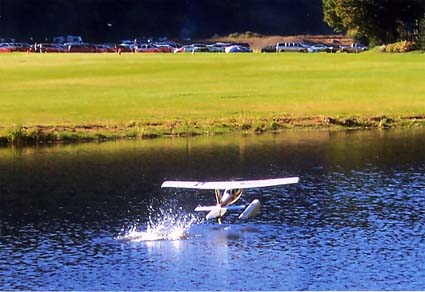 The first photo shows a small seaplane making a pass over the small pond at the Peaceful Valley Campground, home of the NEAT Fair. This pond is a nice "plus" for the NEAT meet.
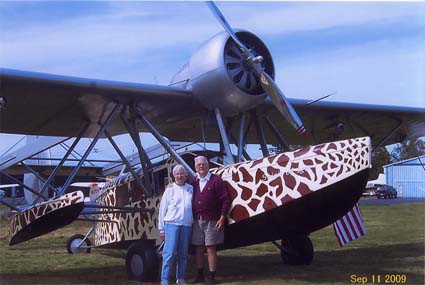 It should be noted that Al Muroc, www.classicaero.com, has models of both available. If you are into seaplanes or Sikorsky types, this is the site to go to.
Electrics at the US Scale Masters Championship
Ken, I just wanted to pass along some great news from the 2009 US Scale Masters Championship event. My electric powered Piper J-3 "Cub" placed third in the Team Scale category. I feel very fortunate. I believe that only a few electric powered models have ever placed at the Championship event. Jeremy Fursman from Snoqualmie, WA did an outstanding job of the flying the J-3 for me. 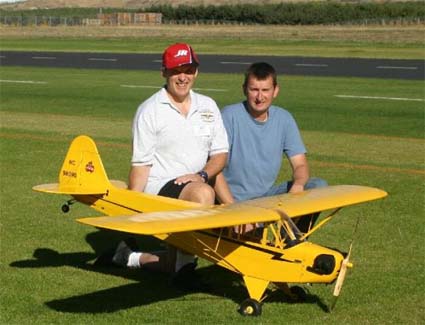 In addition to the third place award we took home plaques for the "Highest Flight Score-Team" and "Most Realistic Flight-Team". The J-3 was built from a SIG kit and is powered by an AstroFlight geared 90 brushed motor with (36) 2400mAh NiCad batteries.  There were also two other electric powered models there competing. I had my 1/4 scale Piper J-4 (20th place in Expert) and Grant Lord from Vancouver, WA competed with his beautiful Fly Baby Bipe (21st place in Expert). 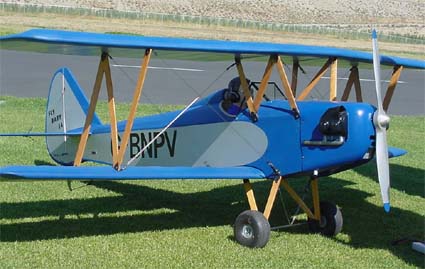 Grant's big bipe has a brushless motor and Li-Poly batteries for power. It flew great and scored a 90.58 flight score average.
Best regards,
Sparrowhawk and More
Hi Ken, Just read the new "Future is Electric" - good stuff as always. Great to see Dave Hipperson's Sparrowhawk work-over. That model is fascinating, of a very sleek and interesting prototype. Yes, I've seen the 'real one' but only on the ground way back before we left the UK. The good bit, Dave got rid of that colour scheme! Not as bad as the experiences you later describe in this newsletter concerning that Stearman, but the Sparrowhawk's colour scheme as it comes out of the 'big shiny box' is something I know a little about. That red, silver and registration 'G-AESZ' come off the entirely different size, looks and designer/builder 'Chilton DW1' that I designed a 54" span model of back around 1986 - 87. I built and flew her in England, using documentation from "Aeroplane Monthly", an English magazine that leans to older aircraft.
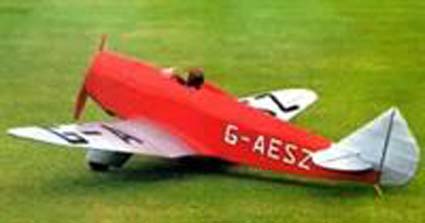 The photos are one of my model and the other of the inspiration. Dave's a 'class act' and did it right. When I pointed this somewhat glaring error out on the E Zone, it was laughed out of court, with some folk suggesting I shouldn't criticize ready-made models, which are all perfect by definition. 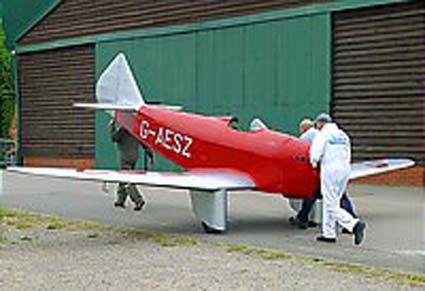 Your thoughts on amending the Stearman! Strikes me as basically a lousy design, with a primary aim of getting folk to buy one. As one who knows well what happens to a bad kit review, the online and other comments about it in that area don't surprise me. I'm very selective over what I review these days, like hardly anything. The last two both came from Sig! Aside from the discussion on the decalage, that nose-heaviness suggests that the structure is just badly designed. A lighter tail end framework, a little nose length 'fudge', not like it's every going up before scale judges, some internal equipment re-location and it wouldn't have needed any ballast. A model that size needing four ounces of nose weight is not very good.
Actually, you can see I did not edit it Dereck. It is not a totally lousy design. I believe that, maybe, it was brought to market just a little too quickly and more care could have been taken in preparing the manual and a couple of adjustments could have been made to the basic airframe and equipment placement to make it even better. All flight reports, by intermediate and advanced pilots, indicate that it is a good flier and a fun to fly plane. I am very impressed with the overall engineering, as it would have gone together very well as an ARF. It seems quite popular, and pretty much rightly so, for the most part. Time will tell how my highly modified version will turn out. KM And finally! I have to tell someone - actually, about everyone! Sue, my wife, just accepted a position of Vice President in the development area of a major non-profit in Chicago. After over fifteen years in the DC area, we are now frantically preparing to paint up this place to rent or sell, pack and move to an apartment in the middle of Chicago and the inevitable bunch of stuff that moving demands. The aim is to drop off the world, work our rear ends off to re-establish our lives a long ways north-west to get back to normalcy ASAP and re-appear doing normal stuff real quick! There will be a lot of change - for starters, neither of us has ever lived in an apartment high-rise smack in the middle of a big city before. Suspect one change will involve me making smaller models around A123 batteries - I don't fancy Li-Poly batteries on the 50th floor with no balcony!
Regards
The February EFO Meeting The February EFO meeting was held at Jim Young's in Brighton, MI. Thank you Jim for hosting!
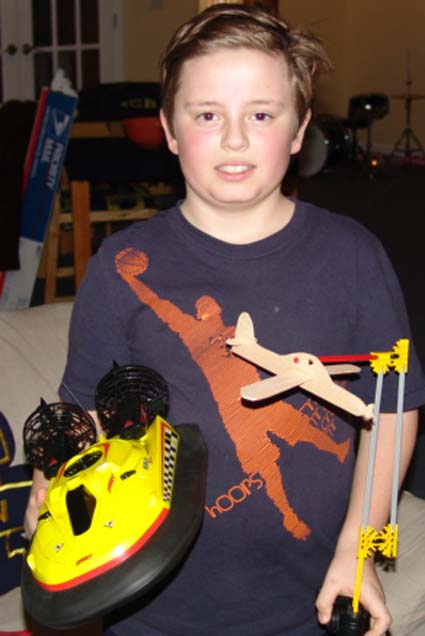 Tim Young showed his hovercraft and a display model that he made as part of a school project. He loves scooting the hovercraft about the house! 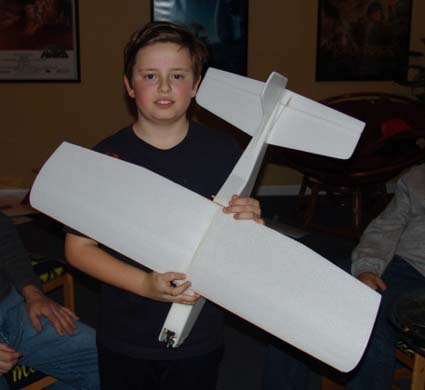 Tim also shared his Blu Baby. It recently was involved in one of the Spektrum receiver glitches that have shown up at the Ultimate Soccer Arenas. Joe Hass has followed up on the glitches and did a presentation for the Skymasters on how to avoid them when flying at the Arenas.
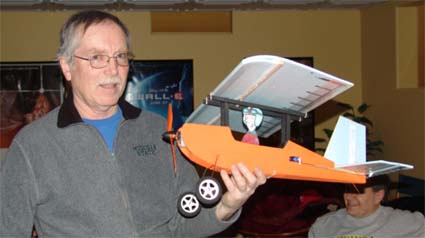 Richard Utkan scratch built a Fred-e from foam. He looked at the photos and created a TLAR (that looks about right) model. He said that it is a very nice flier. 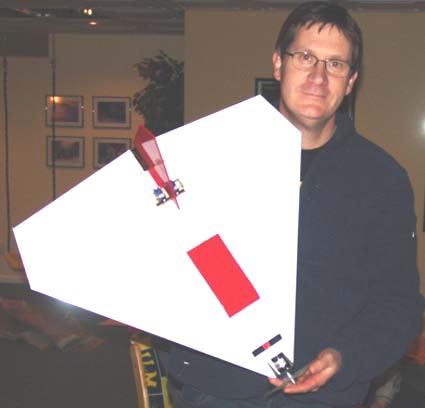 Dave Stacer shared his flying wing Aggressor with us.
He'd purchased several items for this build from a place on the Internet called Deal Extreme. He followed up our meeting with an email containing the following information about Deal Extreme. "Here is the website I was talking about last Thursday.
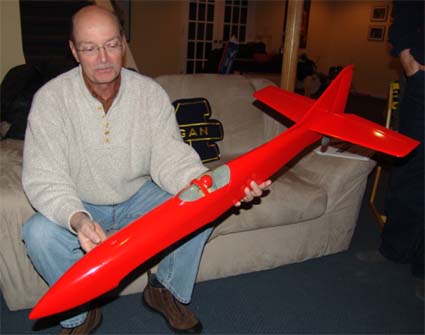 Denny Sumner has been building a prototype Super Sportwin along with the designer, Mark Rittinger. He had the fuselage ready to share at the meeting. It has a knockout covering job and super looking cockpit. More information on this model can be found in the RC Groups thread at
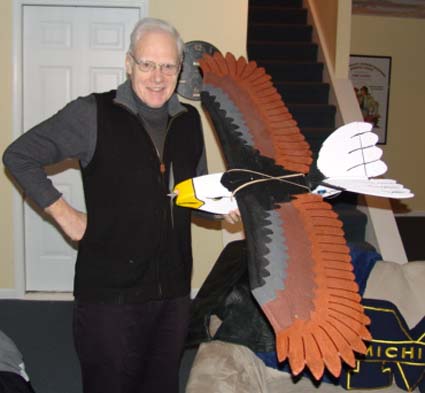 Arthur Deane showed his foam scratch-built Eagle. He enjoyed watching a similar model fly at the last Mid-Am and decided that he had to have one. He did make a change to the airfoil. His is a Clark-Y rather than the typical KM-type. 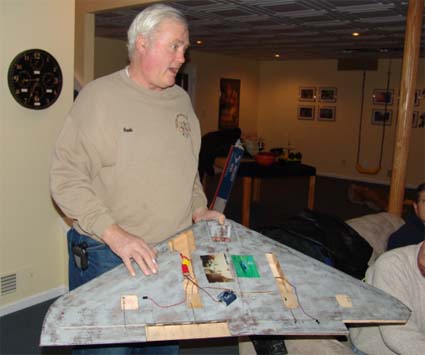 Hank Wildman shared the features that he's building into the rework of his A-6 Intruder. It has beautifully engineered split flaps and an excellent hinging system on all surfaces. He had it hooked up so that he could demonstrate the surface movements. 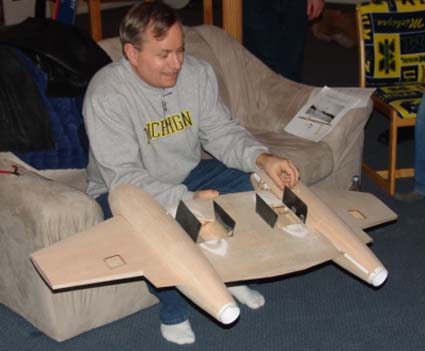 Jim Young showed the progress on his Gloster Meteor. He'd just finished up the gear doors, made from carbon fiber, on the wings. More information on this build can also be found on RC Groups at
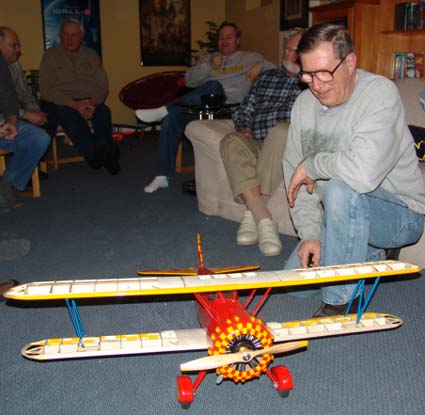 Ken Myers showed the progress on his Super Stearman, which he is converting from the E-flite PT-17 Stearman ARF. This has turned into a "full-time job" for him. After the show and tell portion of the meeting was over, we all retired to Jim's well-stocked workshop where we talked "airplanes" well into the evening. Jim shared even more of his Gloster Meteor project and answered some questions concerning the many designs and kits he is marketing.
EFO Members READ THIS! The next EFO meeting will be on Thursday, March 11, 7:30 p.m. at Ken Myers' house. This is a break from our traditional first Thursday of the month meetings!
Help When Using Spektrum Radios As mentioned earlier, there had been a few problems with using Spektrum radio systems during the indoor flying at the Ultimate Soccer Arenas. Joe Hass gathered information and did a presentation at the Skymasters on how to properly setup and use Spectrum radios. He sent along the following information via email. KM Ken, Here is a wealth of information supplied by Horizon. It can be passed on to whomever you like. (I looked on the Internet for this information and could not find a link to it. I've posted the .pdf file to homepage.mac.com/kmyersefo/Customer-care-pak2-1.pdf KM) Did you know that when you bind a Spektrum system the stick positions when you bind become the failsafe? More than once, when I have bound I gyrated the sticks as I was trying to push the button and bind at the same time. If there was a loss of communication the aircraft would revert to the crazy position I pushed the stick to.
Joe Hass Also from Joe Regarding the writer in the latest AMPEER...
spektrumrc.com/Community/InstallationBestPractices.aspx Crimping Warning
Hi Ken, I noted your reference to crimping the connectors on the Li-Poly battery. I too used to crimp the connectors. One day I was doing my Safety test of gently pulling the connector whilst holding the wire, when lo and behold, the connector started to slide off the wire. About 20% of my batteries had solder connections, the remainder were made up at about the same time and I thought that crimping would save me a lot of time since there were so many batteries to make up.
All the very best to you,
I agree with Robert that it is a good idea to check your battery connections frequently. It is just an excellent safety practice. I've used Anderson Power Poles since entering electric flight. I have the APP crimper and I've never discovered intentionally or inadvertently a loose crimped connection. Robert didn't say how he crimped his connectors, but I've found the APP crimper, and most likely the similar, but less expensive West Mountain crimper, to provide excellent crimps. The really important thing is to check the integrity of your connections whether they be crimped or soldered. It is just a good safety practice. Thanks for the reminder Robert. KM Problems with Long Battery Lead Wires
Hi Ken, I have inherited a twin-ducted fan GWS ME-262 brushless 2028 inrunner powered, ready to fly. It had twin speed controls mounted on each engine nacelle and battery wires from a 2200mah 3S Li-Poly pack in the nose through "Y" connection to the speed controls mounted on each engine nacelle, The total length was about 28 inches. I had a number of nice flights before it crashed due to one motor cutting and asymmetric thrust.
Gary Gullikson Well, there you go Gary. Thanks for the mention. This same topic has come up with the Gloster Meteor that Jim Young is building. KM Put This One On Your Event Schedule!
The Balsa Butchers will once again be hosting the "Keith Shaw Birthday Party Electric Fly-In" at their field near Coldwater, MI. The event will take place on June 5 and 6, 2010.
|
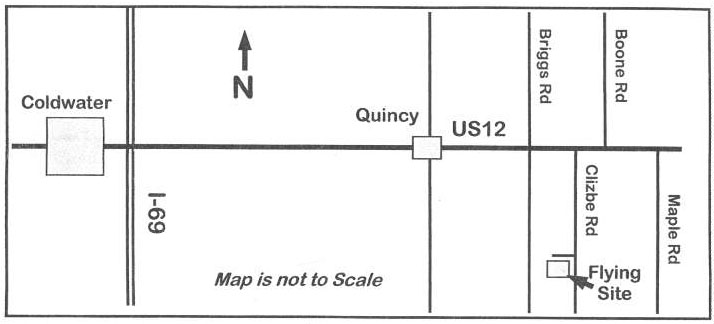
|
I love this meet. There is a lot of laid back flying with some of the Midwest's best pilots, Electric Flight Designers, Builders and Authors. I wouldn't miss it! It is a lot of fun for everyone with an interest in electric flight. KM How Drive Calculator Can Help In Prop Selection even if the Motor is Not in the Database
EFO member, Arthur Deane asked how to find a starting prop for a Himax HC 3510-1100 when it doesn't appear in the database for Drive Calculator (www.drivecalc.de).
You'll find the data for the HC 3510-1100 at www.maxxprod.com/pdf/HC3510-1100.pdf
Wing Cube Loading, Once Again
The February 2010 issue of Model Aviation contained some information that once again proved the value of wing cube loading, or as I like to call it cubic wing loading. Besides the absolutely fantastic article by Bob Benjamin about rebuilding a crashed E-flite AT-6, there were several other articles about the AT-6.
The CWL numbers for the AT-6s indicate that they are for advanced sport pilots, just as their full-size counterparts were for pilots in advanced training. Don't let the word "Trainer", which is often associated with the AT-6, allow you to think of it as anything but an advanced trainer.
A Couple in Interesting Links I'm not a great believer in the next great power source coming down the pipeline, but fellow EFO member, Dave Stacer, sent the following link. It apparently shows a RC model car being powered by a hydrogen fuel cell electric system. www.engadget.com/2010/02/03/horizon-debuts-h-cell-2-0-hydrogen-fuel-cell-system-for-r-c-cars/ Bob Aberle sent along a link. It is a free, on-line Electric Power Magazine with reviews and construction articles. It appears that Henry Holcomb is doing it. Here is the editorial and masthead page.
You might want to check these links out soon. |
To Reach Ken Myers, you can land mail to the address at the top of the page. My E-mail
address is:
KMyersEFO@mac.com
EFO WEBsite: http://homepage.mac.com/KMyersEFO/